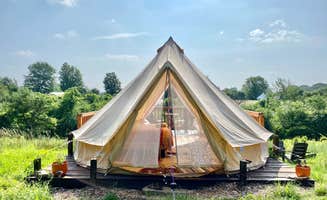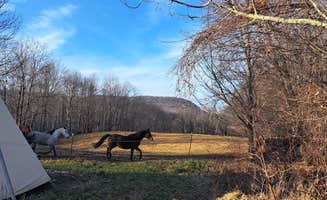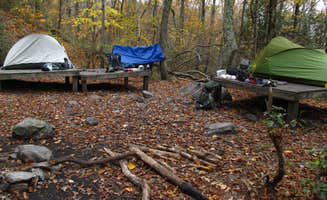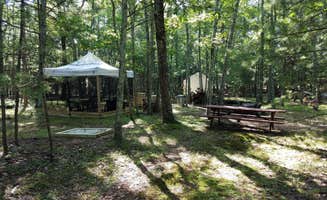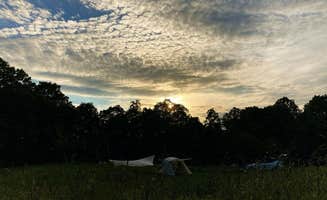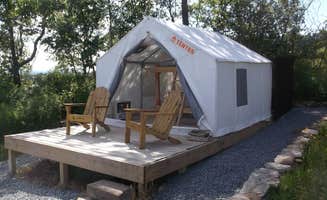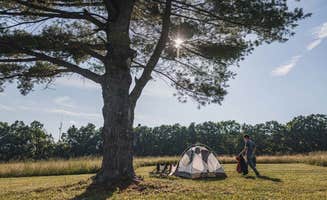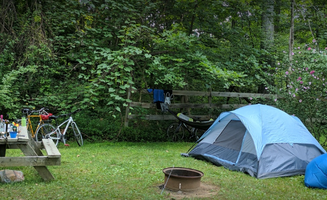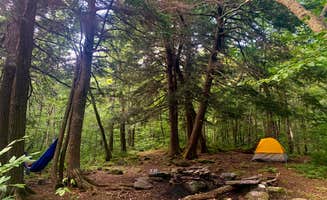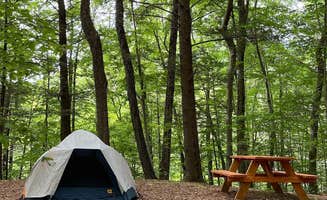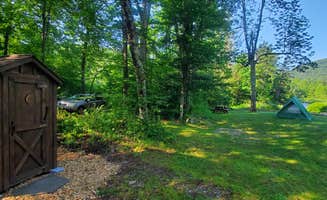Tent camping opportunities near Kinderhook, New York extend throughout the Taconic Mountains and western Massachusetts. Sites range in elevation from 600 to over 2,000 feet, with notable weather variations between valley and ridge locations. Most tent-only areas sit within a 30-45 minute drive from Kinderhook, often requiring modest hikes on established trails to reach campsites.
What to do
Explore mountain trails: At Alander Trail Campground, campers must hike approximately 1.5-2 miles with all gear to reach primitive sites. "You have to park at the entrance and hike in about 1.5-2 miles with everything on your back to get to the spots. Once you get there, theres quite a few sites to choose from and each offer quite a bit or privacy," notes Kay D.
Fish in wilderness lakes: Echo Lake provides fishing opportunities surrounded by hills and forested campsites. James A. reports, "Lake is surrounded by hills and there is a small lean two with a few campfire spots. Other campsites are scattered and require navigating through small overgrown trails (wear pants)." Consider bringing lightweight tackle if backpacking to this location.
Summit nearby peaks: The Bear Mountain area offers challenging day hikes from established campsites. "Make sure to hit the summit of Bear Mountain; incredible view!" advises Nora S. about camping at Riga Lean-To. Hikers should allow 4-6 hours for round-trip summit excursions from most camping areas.
What campers like
Privacy between sites: Most tent campers appreciate the seclusion at primitive sites. "It's completely free and it usually isn't too busy since most people don't like having to carry all their stuff in that far," notes Kay D. about Alander Trail Campground. Sites typically require 5-20 minute walks between neighbors.
Bear protection infrastructure: Brassie Brook Shelter and other Appalachian Trail sites provide bear boxes for food storage. "There's also a bear box near by," confirms Tina D. These metal containers accommodate 2-3 backpackers' food supplies and prevent wildlife encounters.
Lean-to options during inclement weather: Several sites offer three-sided shelters. "We ended up stumbling on this campsite on our way to the Riga lean-to, which was a very happy surprise," writes Nora S. Most lean-tos can accommodate 4-6 people on wooden platforms with overhanging roofs.
What you should know
Fire restrictions vary significantly: While Echo Lake permits fires, many higher-elevation sites prohibit them. "No fires allowed, however," notes Nora S. about Laurel Ridge. Always check current restrictions before planning meals requiring cooking.
Rugged terrain challenges: Most tent camping requires moderate hiking abilities. "Be prepared for steep inclines, and lots of rocks," warns Nora S. Trails to campsites typically gain 500-1,000 feet of elevation over 1-2 miles.
Limited facilities at dispersed sites: Primitive camping means minimal infrastructure. "Leave NO Trace! We had a phenomenal time, and definitely recommend!" advises Nora S. Campers must pack out all waste and bring filtration systems for water from natural sources.
Tips for camping with families
Choose shorter access trails: With children, select sites with minimal hiking required. "This campground was my first backpacking trip and it was perfect!" shares Kate about Echo Lake, making it suitable for novice backpackers and families.
Consider timing for popular sites: Echo Lake "can get a little crowded later in the day so you may have to share space with others and it can be a little noisy at night," according to Kate. Arriving mid-week or before noon increases chances of securing preferred sites.
Pack insect protection: Low-lying areas near water can harbor mosquitoes. Kate notes about Echo Lake, "it can get swampy near the edge of the lake so you may want to bring bug spray." Long-sleeved clothing and mesh tents with intact screens are essential during summer months.
Tips from RVers
Use established sites for basecamp: Since most tent camping requires hiking in, RV campers often utilize Rustic Lean-To as a base for day explorations. "This site feature a fire-pit, wooded platform and picnic table," notes Ashley F., making it suitable for those wanting amenities before day hikes.
Consider seasonal access limitations: Many forest roads leading to trailheads become impassable in winter. RVs should plan visits between late May and early October when access roads remain clear of snow and ice.
Vehicle size restrictions apply: Most trailheads have limited parking areas unsuitable for larger RVs. Standard parking spaces accommodate vehicles under 20 feet, with no pull-through options at most wilderness access points.



